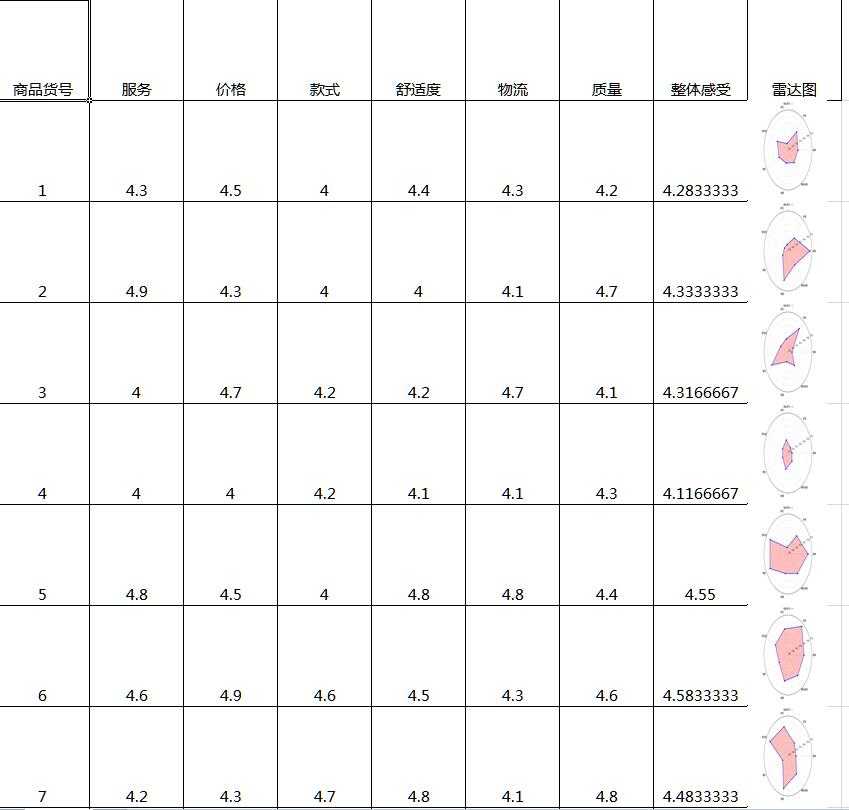怎么批量制作html网页
Posted
tags:
篇首语:本文由小常识网(cha138.com)小编为大家整理,主要介绍了怎么批量制作html网页相关的知识,希望对你有一定的参考价值。
我有一系列的带标题的文章,一个一个用dreamweaver制作网页和链接发布很累,有没有什么工具可以一下子导入全部文章和标题,然后自动生成一系列的html静态网页,并自动生成底部的相互链接的工具吗?然后我一下子上传到ftp服务器就行啦。
向这样
标题:%……¥¥……*((……¥¥……*&
内容:¥%#%*(%^**^%
上一章:*&%$%&*(*%$$^& 下一章:#^*(&%$##%&*(^&%
1|2|3|4|5|6
python批量制作雷达图
老板要画雷达图,但是数据好多组怎么办?不能一个一个点excel去画吧,那么可以利用python进行批量制作,得到样式如下:

首先制作一个演示的excel,评分为excel随机数生成:
1 =INT((RAND()+4)*10)/10
加入标签等得到的excel样式如下(部分,共计32行):

那么接下来就是打开python写码了,本文是基于python3.4进行编写
1 wb = load_workbook(filename=r‘C:\\Users\\Administrator\\Desktop\\数据指标.xlsx‘) ##读取路径
2 ws = wb.get_sheet_by_name("Sheet1") ##读取名字为Sheet1的sheet表
3
4 info_id = []
5 info_first = []
6
7 for row_A in range(2, 32): ## 遍历第2行到32行
8 id = ws.cell(row=row_A, column=1).value ## 遍历第2行到32行,第1列
9 info_id.append(id)
10 for col in range(2, 9): ##读取第1到9列
11 first = ws.cell(row=1, column=col).value
12 info_first.append(first) ##得到1到8列的标签
13
14 info_data = []
15 for row_num_BtoU in range(2, len(info_id) + 2): ## 遍历第2行到32行
16 row_empty = [] ##建立一个空数组作为临时储存地,每次换行就被清空
17 for i in range(2, 9): ## 遍历第2行到32行,第2到9列
18 data_excel = ws.cell(row=row_num_BtoU, column=i).value
19 if data_excel == None:
20 pass
21 else:
22 row_empty.append(data_excel) ##将单元格信息储存进去
23 info_data.append(row_empty)
分步讲解:
读取excel表格:
1 wb = load_workbook(filename=r‘C:\\Users\\Administrator\\Desktop\\数据指标.xlsx‘) ##读取路径
2 ws = wb.get_sheet_by_name("Sheet1") ##读取名字为Sheet1的sheet表
需要用到库:
1 import xlsxwriter
1 from openpyxl import load_workbook
在命令指示符下输入:
1 pip install xlsxwriter
等待安装即可,后面的库也是如此:

将第一列ID储存,以及第一行的标签,标签下面的数值分别储存在:
info_id = []
info_first = []
info_data = []
读取数据后接下来需要设置写入的格式:
1 workbook = xlsxwriter.Workbook(‘C:\\\\Users\\\\Administrator\\\\Desktop\\\\result.xlsx‘)
2 worksheet = workbook.add_worksheet() # 创建一个工作表对象
3 #字体格式
4 font = workbook.add_format(
5 {‘border‘: 1, ‘align‘: ‘center‘, ‘font_size‘: 11, ‘font_name‘: ‘微软雅黑‘}) ##字体居中,11号,微软雅黑,给一般的信息用的
6 #写下第一行第一列的标签
7 worksheet.write(0, 0, ‘商品货号‘, font)
8 ##设置图片的那一列宽度
9 worksheet.set_column(0, len(info_first) + 1, 11) # 设定第len(info_first) + 1列的宽度为11
将标签数据等写入新的excel表格中:
1 #新建一个excel保存结果
2 workbook = xlsxwriter.Workbook(‘C:\\\\Users\\\\Administrator\\\\Desktop\\\\result.xlsx‘)
3 worksheet = workbook.add_worksheet() # 创建一个工作表对象
4 #字体格式
5 font = workbook.add_format(
6 {‘border‘: 1, ‘align‘: ‘center‘, ‘font_size‘: 11, ‘font_name‘: ‘微软雅黑‘}) ##字体居中,11号,微软雅黑,给一般的信息用的
7 #写下第一行第一列的标签
8 worksheet.write(0, 0, ‘商品货号‘, font)
9 ##设置图片的那一列宽度
10 worksheet.set_column(0, len(info_first) + 1, 11) # 设定第len(info_first) + 1列的宽度为11
11
12 ##写入标签
13 for k in range(0,7):
14 worksheet.write(0, k + 1, info_first[k], font)
15 #写入最后一列标签
16 worksheet.write(0, len(info_first) + 1, ‘雷达图‘, font)
制作雷达图:
1 #设置雷达各个顶点的名称
2 labels = np.array(info_first)
3 #数据个数
4 data_len = len(info_first)
5 for i in range(0,len(info_id)):
6 data = np.array(info_data[i])
7
8 angles = np.linspace(0, 2*np.pi, data_len, endpoint=False)
9 data = np.concatenate((data, [data[0]])) # 闭合
10 angles = np.concatenate((angles, [angles[0]])) # 闭合
11
12 fig = plt.figure()
13 ax = fig.add_subplot(111, polar=True)# polar参数!!
14 ax.plot(angles, data, ‘bo-‘, linewidth=2)# 画线
15 ax.fill(angles, data, facecolor=‘r‘, alpha=0.25)# 填充
16 ax.set_thetagrids(angles * 180/np.pi, labels, fontproperties="SimHei")
17 ax.set_title("商品货号:" + str(info_id[i]), va=‘bottom‘, fontproperties="SimHei")
18 ax.set_rlim(3.8,5)# 设置雷达图的范围
19 ax.grid(True)
20 plt.savefig("C:\\\\Users\\\\Administrator\\\\Desktop\\\\result\\\\商品货号:" + str(info_id[i]) + ".png", dpi=120)
图片太大怎么办?用库改变大小即可:
1 import Image 2 ##更改图片大小 3 infile = “C:\\\\Users\\\\Administrator\\\\Desktop\\\\result\\\\商品货号:" + str(info_id[i]) + ".png“ 4 outfile = ”C:\\\\Users\\\\Administrator\\\\Desktop\\\\result1\\\\商品货号:" + str(info_id[i]) + ".png” 5 im = Image.open(infile) 6 (x, y) = im.size 7 x_s = 80 ## 设置长 8 y_s = 100 ## 设置宽 9 out = im.resize((x_s, y_s), Image.ANTIALIAS) 10 out.save(outfile,‘png‘,quality = 95)
将大图片和小图片放在了result和result1两个不同的文件夹,需要再前边创建这两个文件夹:
1 if os.path.exists(r‘C:\\\\Users\\\\Administrator\\\\Desktop\\\\result‘): # 建立一个文件夹在桌面,文件夹为result 2 print(‘result文件夹已经在桌面存在,继续运行程序……‘) 3 else: 4 print(‘result文件夹不在桌面,新建文件夹result‘) 5 os.mkdir(r‘C:\\\\Users\\\\Administrator\\\\Desktop\\\\result‘) 6 print(‘文件夹建立成功,继续运行程序‘) 7 8 if os.path.exists(r‘C:\\\\Users\\\\Administrator\\\\Desktop\\\\result1‘): # 建立一个文件夹在C盘,文件夹为result1 9 print(‘result1文件夹已经在桌面存在,继续运行程序……‘) 10 else: 11 print(‘result1文件夹不在桌面,新建文件夹result1‘) 12 os.mkdir(r‘C:\\\\Users\\\\Administrator\\\\Desktop\\\\result1‘) 13 print(‘文件夹建立成功,继续运行程序‘)
最后插入图片到excel中:
1 worksheet.insert_image(i + 1, len(info_first) + 1, ‘C:\\\\Users\\\\Administrator\\\\Desktop\\\\result1\\\\‘ + "商品货号:" + str(info_id[i]) + ‘.png‘) ##写入图片 2 time.sleep(1)##防止写入太快电脑死机 3 plt.close() # 一定要关掉图片,不然python打开图片20个后会崩溃 4 5 workbook.close()#最后关闭excel
得到的效果如下:

附上完整代码:
1 import numpy as np
2 import matplotlib.pyplot as plt
3 import xlsxwriter
4 from openpyxl import load_workbook
5 import os
6 import time
7 from PIL import Image
8
9 if __name__ == ‘__main__‘:
10
11 if os.path.exists(r‘C:\\\\Users\\\\Administrator\\\\Desktop\\\\result‘): # 建立一个文件夹在桌面,文件夹为result
12 print(‘result文件夹已经在桌面存在,继续运行程序……‘)
13 else:
14 print(‘result文件夹不在桌面,新建文件夹result‘)
15 os.mkdir(r‘C:\\\\Users\\\\Administrator\\\\Desktop\\\\result‘)
16 print(‘文件夹建立成功,继续运行程序‘)
17
18 if os.path.exists(r‘C:\\\\Users\\\\Administrator\\\\Desktop\\\\result1‘): # 建立一个文件夹在C盘,文件夹为result1
19 print(‘result1文件夹已经在桌面存在,继续运行程序……‘)
20 else:
21 print(‘result1文件夹不在桌面,新建文件夹result1‘)
22 os.mkdir(r‘C:\\\\Users\\\\Administrator\\\\Desktop\\\\result1‘)
23 print(‘文件夹建立成功,继续运行程序‘)
24
25 wb = load_workbook(filename=r‘C:\\Users\\Administrator\\Desktop\\数据指标.xlsx‘) ##读取路径
26 ws = wb.get_sheet_by_name("Sheet1") ##读取名字为Sheet1的sheet表
27
28 info_id = []
29 info_first = []
30
31 for row_A in range(2, 32): ## 遍历第2行到32行
32 id = ws.cell(row=row_A, column=1).value ## 遍历第2行到32行,第1列
33 info_id.append(id)
34 for col in range(2, 9): ##读取第1到9列
35 first = ws.cell(row=1, column=col).value
36 info_first.append(first) ##得到1到8列的标签
37 print(info_id)
38 print(info_first)
39
40 info_data = []
41 for row_num_BtoU in range(2, len(info_id) + 2): ## 遍历第2行到32行
42 row_empty = [] ##建立一个空数组作为临时储存地,每次换行就被清空
43 for i in range(2, 9): ## 遍历第2行到32行,第2到9列
44 data_excel = ws.cell(row=row_num_BtoU, column=i).value
45 if data_excel == None:
46 pass
47 else:
48 row_empty.append(data_excel) ##将单元格信息储存进去
49 info_data.append(row_empty)
50 print(info_data)
51 print(len(info_data))
52
53 # 设置雷达各个顶点的名称
54 labels = np.array(info_first)
55 # 数据个数
56 data_len = len(info_first)
57 # 新建一个excel保存结果
58 workbook = xlsxwriter.Workbook(‘C:\\\\Users\\\\Administrator\\\\Desktop\\\\result.xlsx‘)
59 worksheet = workbook.add_worksheet() # 创建一个工作表对象
60 # 字体格式
61 font = workbook.add_format(
62 {‘border‘: 1, ‘align‘: ‘center‘, ‘font_size‘: 11, ‘font_name‘: ‘微软雅黑‘}) ##字体居中,11号,微软雅黑,给一般的信息用的
63 # 写下第一行第一列的标签
64 worksheet.write(0, 0, ‘商品货号‘, font)
65 ##设置图片的那一列宽度
66 worksheet.set_column(0, len(info_first) + 1, 11) # 设定第len(info_first) + 1列的宽度为11
67
68 ##写入标签
69 for k in range(0, 7):
70 worksheet.write(0, k + 1, info_first[k], font)
71 # 写入最后一列标签
72 worksheet.write(0, len(info_first) + 1, ‘雷达图‘, font)
73
74 # 将其他参数写入excel中
75 for j in range(0, len(info_id)):
76 worksheet.write(j + 1, 0, info_id[j], font) # 写入商品货号
77 worksheet.set_row(j, 76) ##设置行宽
78 for x in range(0, len(info_first)):
79 worksheet.write(j + 1, x + 1, info_data[j][x], font) # 写入商品的其他参数
80
81 for i in range(0, len(info_id)):
82 data = np.array(info_data[i])
83
84 angles = np.linspace(0, 2 * np.pi, data_len, endpoint=False)
85 data = np.concatenate((data, [data[0]])) # 闭合
86 angles = np.concatenate((angles, [angles[0]])) # 闭合
87
88 fig = plt.figure()
89 ax = fig.add_subplot(111, polar=True) # polar参数!!
90 ax.plot(angles, data, ‘bo-‘, linewidth=2) # 画线
91 ax.fill(angles, data, facecolor=‘r‘, alpha=0.25) # 填充
92 ax.set_thetagrids(angles * 180 / np.pi, labels, fontproperties="SimHei")
93 ax.set_title("商品货号:" + str(info_id[i]), va=‘bottom‘, fontproperties="SimHei")
94 ax.set_rlim(3.8, 5) # 设置雷达图的范围
95 ax.grid(True)
96 plt.savefig("C:\\\\Users\\\\Administrator\\\\Desktop\\\\result\\\\商品货号:" + str(info_id[i]) + ".png", dpi=120)
97 # plt.show()在python中显示
98
99 ##更改图片大小
100 infile = "C:\\\\Users\\\\Administrator\\\\Desktop\\\\result\\\\商品货号:" + str(info_id[i]) + ".png"
101 outfile = "C:\\\\Users\\\\Administrator\\\\Desktop\\\\result1\\\\商品货号:" + str(info_id[i]) + ".png"
102 im = Image.open(infile)
103 (x, y) = im.size
104 x_s = 80 ## 设置长
105 y_s = 100 ## 设置宽
106 out = im.resize((x_s, y_s), Image.ANTIALIAS)
107 out.save(outfile, ‘png‘, quality=95)
108
109 worksheet.insert_image(i + 1, len(info_first) + 1,
110 ‘C:\\\\Users\\\\Administrator\\\\Desktop\\\\result1\\\\‘ + "商品货号:" + str(
111 info_id[i]) + ‘.png‘) ##写入图片
112 time.sleep(1) ##防止写入太快电脑死机
113 plt.close() # 一定要关掉图片,不然python打开图片20个后会崩溃
114
115 workbook.close() # 最后关闭excel
以上是关于怎么批量制作html网页的主要内容,如果未能解决你的问题,请参考以下文章
